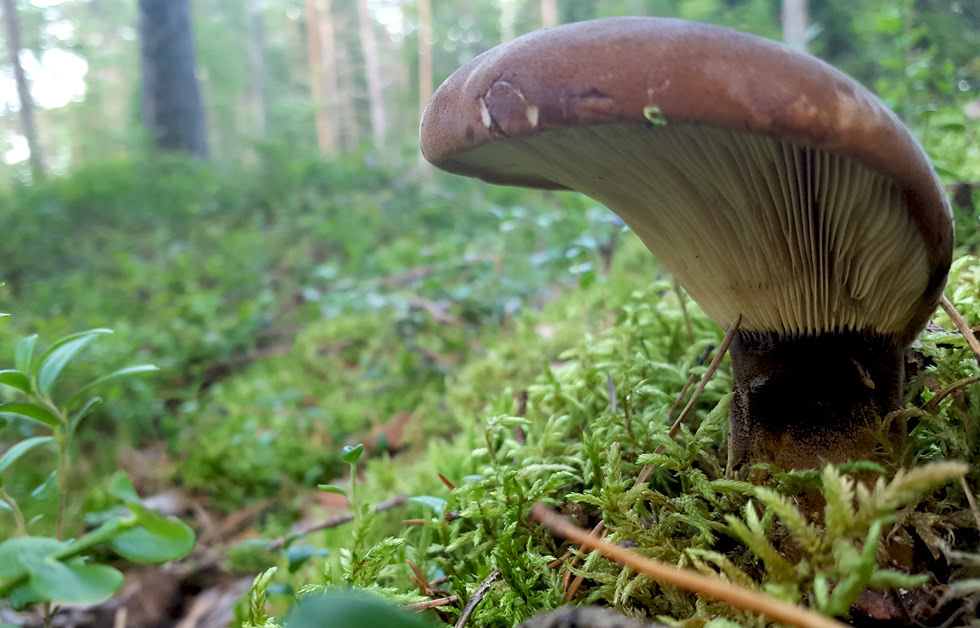
Mushrooming is a nice activity to do in autumn. And these days, there are a lot of mushrooms in forests thanks to the damp weather.
Before taking mushrooms home, you should know which species they are. It’s important to learn to identify the mushrooms you would like to eat. And it’s even more important to identify those you absolutely should not eat.
It’s also nice to learn to identify all kinds of species you spot when you’re foraging mushrooms or just having a normal walk. My favourite activity in this autumn is (forgive me if someone else has invented this term before me) funging. It’s like bird watching, or birding, but for fungi.
For a funging trip, you need an up-to-date, comprehensive, and good mushroom book, a camera, and a mushroom knife/brush that is also nice if you want to take a closer look at a mushroom.
Your identification skills will improve quickly if you pick interesting-looking mushrooms in the forest, sit down and start to examine them slowly by smelling them or, in some cases, by tasting (spit out the sample after tasting it. Not a single bit of a poisonous mushroom or a mushroom you cannot identify should get into your digestive system. And use your discretion when tasting mushrooms. It’s better to taste only the mushrooms you can identify and know for sure they are not poisonous)
A few things to take into consideration when you are learning to identify mushrooms:
• General appearance
• Colour
• Smell
• What’s under the cap? Gills, pores, or teeth?
• What’s the colour of the above-mentioned? Are they close to each other or is there space between them? How thin they are? How do they attach to the stem, or do they?
• Does the mushroom exude latex?
• What are the cap and the stem like?
• Is there some kind of covering, pattern, down, or something else on the surface of the mushroom, the cap, or the stem, or under the cap?
As soon as you learn to identify different species, you start to see them more and more often in the forest. You also learn quite quickly which mushrooms grow in which kind of terrain.

Blue-girdled webcap exudes a lot of mucus. The reason why this mushroom interested me was its beautiful purple, long stems. It belongs to the genus Cortinarius. I've been learning to identify the fungi of this genus because there are so many of them in Finnish forests. Not because I’m interested in eating them. As a group, they are very interesting mushrooms.

This one is quite a common fungus, but not always easily identifiable. It’s velvet bolete, but I mistake it often with slippery jack. They both are edible and can be used in same dishes, so it doesn’t really matter, but it’s still good and responsible to be 100% sure which species you pick for your dinner.

This mushroom was a funny one. Be brave and choose to identify random little fungi. It might be a challenging task, but all the more rewarding. Especially as mushrooms seem to have most peculiar names. Who would have known at first sight that this one is called bell omphalina?

It's quite easy to identify the orange birch boletes by their downy stems and the flesh that turns dark when cut. These boletes need to be well cooked, otherwise you’ll have pains in the stomach (15-20 minutes, perfect for risottos, pies, pasta sauces, and other dishes that need longer cooking). They are the best boletes for risotto in my opinion. Some people don’t like the fact that they turn so dark when cooked, but I think it brings some beautiful contrast to the dish.
You can identify different orange birch boletes by the trees at the base of which they grow, in addition to other characteristics (the colours of the cap, the down, and the stem).

Such a beauty, easily identifiable as some sort of pleurotus. With a closer look, you can see that the surface of the fungus, especially its stem, is covered with velvety down. The name of this beautiful organism is, of course, velvet roll-rim.

Warning! When you’re mushrooming, you may spot other interesting organisms, too, like this brave little fellow, very interested in my mobile, also known as slowworm.
Have great funging you all!
In addition to a mushroom guide and knife, it’s good to pack also a compass and a map into your backpack, and why not even a GPS device. In case autumn darkness catches you, it’s also good to have a high visibility vest and a light with you.





 hodnotenia
hodnotenia